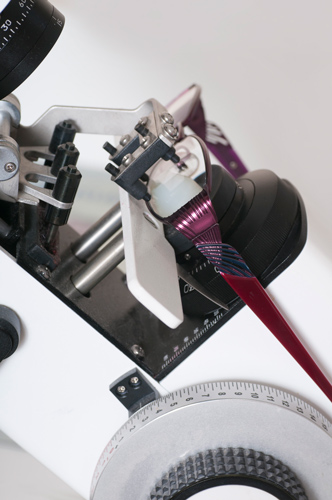As an optician, you will use a lensometer on a daily basis. In The Masters in Lensometry (Part 1), we discussed the basics, from focusing the eyepiece and calibrating the lensometer, to starting with simple spherical lenses. As stated in the last article, if you are a seasoned optician trying to share your knowledge with others, start with these basics.
What should you do after you get the basics down? Here is what I do in my courses and suggest to those learning lensometry. Once you have mastered spherical lenses, move on to learn sphero-cylinder lenses. However, do not just use any sphero-cylinder lens. I always start with high minus sphero-cylinder lenses. Those of us who have done this long enough know it is much easier to read a high cylinder lens than a 0.25 cylinder lens.
Remember the position of the eyewear is important. Glasses are positioned in the lensometer by placing the back surface against the lens stop, with the temples pointing away from you. It is very important to have the glasses level on the spectacle table, especially when reading a sphero-cylinder lens.
 When beginning to neutralize lenses, some may be unsure of how to distinguish between a spherical lens and a sphero-cylinder lens. Hint: If the two sets of mires cannot be focused at the same time, or both sets of mires appear broken, the lens is a sphero-cylinder.
When beginning to neutralize lenses, some may be unsure of how to distinguish between a spherical lens and a sphero-cylinder lens. Hint: If the two sets of mires cannot be focused at the same time, or both sets of mires appear broken, the lens is a sphero-cylinder. To determine the power of a sphero-cylinder lens, focus the sphere and cylinder mires separately. To begin, place one hand on the axis wheel, the other on the power wheel. Turn the power wheel into the plus and move toward the minus. At the same time rotate the axis wheel until the sphere lines are unbroken and in sharp focus. Make sure the target is centered in the reticle. Reminder: The sphere lines are the three “skinny” lines. The lens sphere power is the power at which the “skinny” lines come into focus. Record this as your sphere power or first reading. Important: Sphere mires must focus at a more plus power (or less minus power) than the cylinder lines. If the cylinder mires focus at a more plus power than the sphere lines, rotate the axis wheel 90 degrees and start over.
Continue to read the cylinder power of the lens. Do not move the axis wheel, continue to focus the three “thick” lines in the minus power power direction until your “thick” lines are in focus. Record this value as your second reading, but this is not your cylinder power. The cylinder power is the difference between your first reading and your second reading. Record the power in minus cylinder form. For example, “skinny mires/first reading” came into focus at -2.00 with an axis 075, and then the “thick mires/second reading” came into focus at -3.00. The recorded power of the lens is -2.00 -1.00 x 075.
The best way to be a master in lensometry is to neutralize lenses every day and to use many different powers. Practice makes perfect. As a suggestion, check out local or national hands-on lensometry courses. Vision Expo East and West offer great options for hands-on lensometry courses to improve your skills and knowledge. Opticians should be a master in lensometry!












